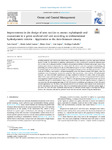Improvements in the design of nest cavities to attract cephalopods and crustaceans in a green artificial reef unit according to tridimensional hydrodynamic criteria – Application to the Ares-Betanzos estuary

View/
Use this link to cite
http://hdl.handle.net/2183/35290
Except where otherwise noted, this item's license is described as CC BY 4.0 https://creativecommons.org/licenses/by/4.0/
Collections
- Investigación (EPEF) [590]
Metadata
Show full item recordTitle
Improvements in the design of nest cavities to attract cephalopods and crustaceans in a green artificial reef unit according to tridimensional hydrodynamic criteria – Application to the Ares-Betanzos estuaryDate
2023-10-09Citation
Carral, L., Lamas, M.I., Fouz, M., López, I., Carballo, R., 2023. Improvements in the design of nest cavities to attract cephalopods and crustaceans in a green artificial reef unit according to tridimensional hydrodynamic criteria – Application to the Ares-Betanzos estuary. Ocean & Coastal Management 245, 106871. https://doi.org/10.1016/j.ocecoaman.2023.106871
Abstract
[Abstract]: Installing artificial reefs (ARs) on the seabed creates a hard substrate that alters water flow and causes different species to settle. For this reason, by applying hydrodynamics to ARs, a useful tool is created for analysing these reefs so that there is adequate nutrient circulation and a propitious habitat for benthic and pelagic fauna. Using hydrodynamic criteria to characterise the velocity field, the present work aims to propose a methodology for
positioning nest cavities within an AR unit in which different species will settle. Biological considerations, such as nutrient supply as well as the most suitable size and shape for the nest cavities, are taken into account. A stateof-the-art 3D shallow water model is validated and applied to the Ares-Betanzos estuary (NW Spain), where the installation of an AR group has recently been proposed. This coastal body, with a complex 3D hydrodynamic
structure, was achieved under representative average conditions in absence of winds, which in turn greatly differs both in space and time throughout a spring-neap tidal cycle. A 3D CFD (Computational Fluid Dynamics) tool is applied to model food delivery on the AR. Moreover, the optimal geometry and position of nest cavities are established through a created indicator, ARnest cavity position, in order to provide sufficient nutrient circulation. It
was found that the most appropriate shape for the nest cavities is cylindrical and a diameter of 200–300 mm is the most appropriate size. In terms of the ideal positions for the nest cavities, these depend on the orientation of the AR with respect to the current velocity. One of the orientations analysed leads to sufficient nutrient supply to the whole AR, while the other orientation analysed leads to sufficient nutrient supply to the high and mid positions
at the front face, mid and low positions at the back face and all positions along the lateral faces.
Keywords
Artificial reef
Estuary
Currents
CFD
Numerical modelling
Estuary
Currents
CFD
Numerical modelling
Editor version
Rights
CC BY 4.0 https://creativecommons.org/licenses/by/4.0/
ISSN
1873-524X






